The Bag Closures Market is estimated to be valued at USD 243.5 billion in 2025 and is projected to reach USD 421.4 billion by 2035, registering a compound annual growth rate (CAGR) of 5.6% over the forecast period.
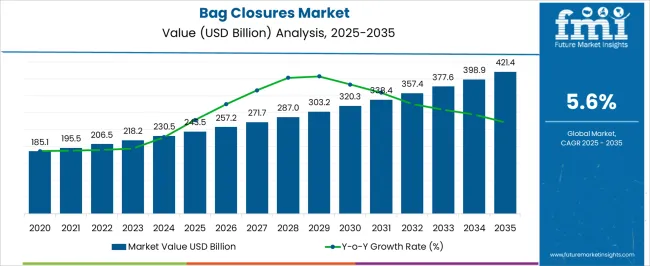
| Metric | Value |
|---|---|
| Bag Closures Market Estimated Value in (2025 E) | USD 243.5 billion |
| Bag Closures Market Forecast Value in (2035 F) | USD 421.4 billion |
| Forecast CAGR (2025 to 2035) | 5.6% |
The bag closures market is gaining momentum driven by increasing demand for convenient, reliable, and sustainable packaging solutions across multiple industries. Rising consumer preference for fresh and resealable packaging, especially in the food sector, has fueled adoption of innovative closure formats.
Technological improvements in materials and product design have enhanced durability, ease of use, and compatibility with automated packaging systems. Environmental considerations are also prompting manufacturers to explore recyclable and biodegradable closure materials, aligning with regulatory initiatives and consumer expectations.
Expanding retail channels and e commerce platforms are further influencing the need for secure and tamper evident packaging. The market outlook remains strong as food safety requirements, extended shelf life goals, and global sustainability commitments continue to shape innovation and growth in bag closure solutions.
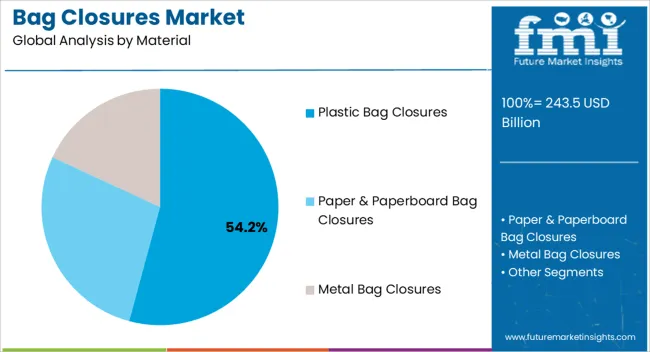
The plastic bag closures segment is projected to contribute 54.20% of total revenue by 2025 within the material category, positioning it as the leading segment. This dominance is being driven by cost effectiveness, versatility, and widespread availability.
Plastic closures provide superior sealing, lightweight performance, and are easily adaptable to different bag formats used across food, retail, and household applications. Their compatibility with high speed production lines and reusability factors have reinforced their continued preference among manufacturers.
As packaging companies focus on balancing durability and sustainability, plastic bag closures maintain a strong presence due to their reliability and established use across global markets.
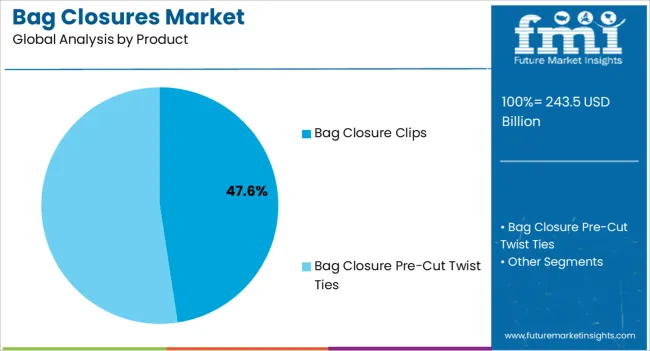
The bag closure clips segment is expected to account for 47.60% of overall market revenue by 2025 within the product category, making it the most prominent segment. This position is attributed to the convenience, reusability, and user friendly design of clips that allow for effective sealing and preservation of product freshness.
Their adaptability across various bag types and ease of application for consumers have increased their acceptance across retail and household packaging. Bag closure clips also support branding and differentiation opportunities, as they can be customized in shape, color, and size.
These features, combined with cost efficiency and recyclability, have strengthened their role in modern packaging solutions.
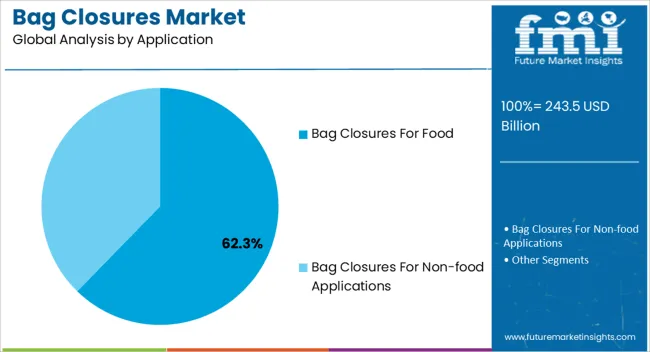
The bag closures for food application segment is projected to hold 62.30% of total market revenue by 2025, emerging as the dominant application area. This growth is supported by rising global demand for packaged and processed foods that require secure and resealable packaging formats.
The segment benefits from heightened focus on food safety, freshness preservation, and compliance with hygiene standards. The adoption of bag closures for food has been further enhanced by the growth of ready to eat meals, bakery products, and snack categories.
Expansion of organized retail and e commerce channels has accelerated reliance on effective closure systems to protect food products during storage and transportation. As consumer lifestyles shift toward convenience and quality, bag closures for food remain the critical driver of demand within the overall market.
Increasing Demand for Reusable Packaged Food Products Drive Sales of Bag Closures & Seals, Especially Clips & Twist Ties
Sales of bag closures are closely linked to the demand for reusable packaged food products, the popular of which are bakery and confectionery items. Flexible packaging for bread processing is the prominent end user of bread clips, which number millions daily. As sales of bakery products continue to reflect above-average consumption habits, demand for these bag clips is projected to hold steady.
In addition to bread, many cafés and bakery chains worldwide have increased demand for clips and twist ties. As these are used to close coffee, tea, and other products effectively. Thus, sales of bag closures are estimated to keep increasing over the coming years.
Availability of a Wide Range of Bakery Products to Augment Demand for Bag Closures and Seals
The introduction of a broad variety of bakery products for diet and health-conscious consumers, such as gluten-free and sugar-free, has also increased demand for bag closures. Thus, during the projection period, a rising consumer base for baked and confectionery goods is expected to add to the sales of bag closures.
Furthermore, various government and non-government organizations are working to limit the use of plastic in packaging. This has raised awareness within the packaging and plastic industries.
On the plus side, this has resulted in a considerable increase in demand for twist ties and the use of paperboard to manufacture re-closures. Twist ties are predicted to be significantly more environmentally friendly than plastic clips and are estimated to aid in eliminating single-use plastic.
Increasing Fashion Trend among Working Women Driving Need & Sales of Bag Clasps and Closures
The growing female workforce and increased brand recognition are fuelling global demand for handbags. Over the past several years, expanding the availability of designer bags in various styles has raised the demand for handbags.
Worldwide, the increased use of handbags among working-class women is projected to be a prominent trend. Rising demand for handbags subsequently increases the sales of bag clasps and closures.
Bag clasps and closures are available in different designs and sizes. An increase in the standard of living and the rising fashion craze is estimated to propel the demand for bag clasps and closures.
Increasing Environmental Awareness & Easy Availability of Durable Substitutes to Hinder Market Growth
During the projection period, easy availability of strong replacements and rising environmental concerns among people are projected to stifle market growth. Significant R&D expenditure on other cheaper products may also threaten market expansion.
As the general public becomes more aware of environmental concerns due to various programs on global warming. The population's thought process is shifting towards necessity over luxury. This can pose challenges to the market as fewer people are making multiple purchases and using the same products for longer periods.
The market expanded at a CAGR of 4.1% from 2020 to 2025. Demand for bag closures has risen dramatically in recent years. Bag closures and seals have regularly used packaging solutions for the packing and sealing of various sorts of bags.
Bag closures and seals are used for reclosing or sealing flexible bags made of less expensive materials with basic but effective designs. Bag seals and closures are commonly used in the food industry for baked goods, confectionery, powdered tea & coffee, and other products. Bag closure and seal manufacturers offer goods that can be used as labels or tags to display product and manufacturer information.
The global market is characterized by supply closure and seal products. Such as bread clips or bag closure clips, magnetic bag closures, drawstring closures, snap bag closures, zip closures, flap bag closures, clasp bag closures, tote bag closures, bag fasteners, and more. Various bag closure types are available in the market. Bags' weight and other physical parameters determine the strength and material capacity of bag closures and seals.
Furthermore, bag closure demand is influenced by its visibility among the target client group. A product such as a bag closure was previously beyond the reach of retail customers. It was only with the growth of organized retail that specialized and unique products such as bag closures began to emerge.
A wide range of items, including bag closures, have benefited from this transition. The evolution of e-commerce platforms from buying points to shopping platforms is one underlying driver. Due to the customers' continued exploration and experimentation with new items; products such as bag closures have found their way into mainstream customer marketplaces.
Biodegradability Quality of Paperboard Clips Dramatically Reduces Waste Caused by Plastic Clips
Paperboard is projected to be a game-changing material, ushering in a new era in the global market. Its strong design and biodegradability are likely to make it a popular alternative to plastic in clip production. Paper fastener evolution has been vital in reimagining the clips for appropriate closure.
According to this study, the paperboard segment is expected to represent an incremental opportunity by 2035. While complete replacement of plastic in packaging is unlikely, usage of paperboard clips is a relatively small product. It is expected to significantly impact the reduction in the accumulation of plastic trash.
North America to Hold Dominant Market Share Through 2035
The global market has been studied across North America, Latin America, Europe, East Asia, South Asia & Pacific, and the Middle East & Africa (MEA). The North America bag closures market accounts for a higher market share of around 38.5% in 2025. North America is estimated to continue to lead the global market, as demand for frozen meats, bread, and other packaged foods is expected to stay strong throughout the forecast period.
The Europe market is expected to account for a market share of around 18.9%. Clips are estimated to likely benefit from increased cereals for breakfast consumption across Europe. These are mostly employed in home settings and are accessible to retail consumers at mom-and-pop retail establishments. The rising cost of coffee and tea has also driven demand for resealing closures to keep them from spoiling due to air moisture.
The Latin American market is estimated to account for 9.7% of the global market share in 2025. Bag closure production in Latin America is keeping up with demand, but small and regular packaging companies are expanding their services to include bag closures.
The Asia Pacific market is estimated to account for 28% of the global market share in 2025. Plastic bag re-possibility has given the market a substantial consumer base in the Asia Pacific. Clips and twist ties are now employed in various industries to re-close flexible packaging solutions, such as those used in agriculture, food and beverages, and garbage disposal.
The demand for bag closures in MEA is expected to progress slower than other regions, but this is expected to change slightly towards the end of 2035. In 2025, the market in MEA accounted for a 4.8% share of the global market.
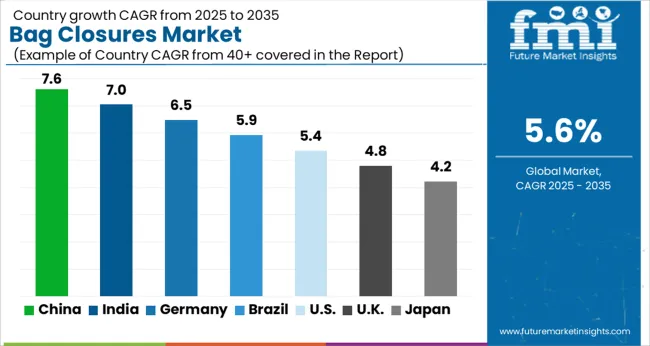
Rising Food & Beverage Industry Driving Consumption of Bag Closures and Seals
As demand for baked products rises, China is estimated to provide enormous potential, putting East Asia on the globe. Dietary changes and substituting bread and other sweet foods for traditional meals are estimated to help this market grow.
Although China is recognized as being a tea-drinking country, coffee is gaining appeal, particularly among young Chinese customers. China's rising food and beverage industry is estimated to contribute significantly to the demand growth for bag closures. China is securing a CAGR of 7.9% in the global market by 2035.
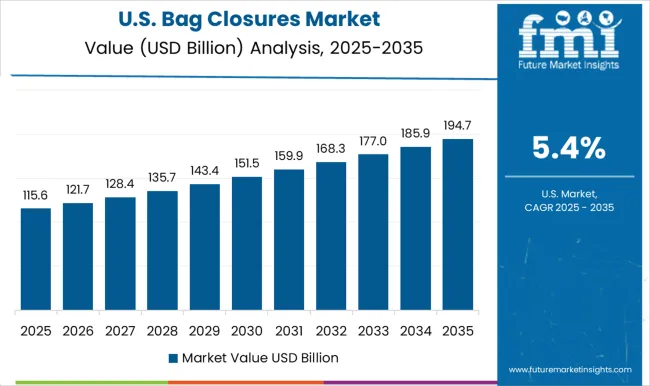
Rising Demand for Healthcare Products to Drive Sales of Bag Closures
The prevalence of obesity and other health conditions has increased in the United States, igniting a renewed sense of health and fitness among the populace. Growing emphasis on health and fitness has boosted demand for healthy drinks, driving bag closure sales.
Other factors driving bag closure shipments in the United States include large beverage makers, a high spending potential population, and rising demand for alcoholic beverages, spirits, healthy drinks, and RTD beverages. The United States is registering a share of 31.8% in the global market during the forecast period.
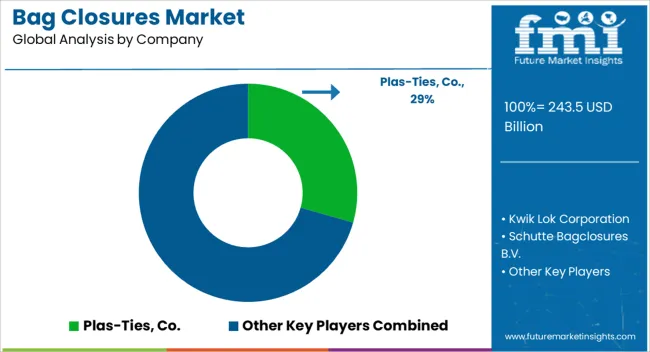
The bag closures market is fragmented, with regional and global companies competing. The rise of regional companies and increasing investments in upstream applications are shaping the competitive landscape.
Leading bag closure manufacturers such as Kwik Lok Corporation, Schutte bag closures B.V., Bedford Industries Inc., Multi-Pack Solutions LLC, Plas-Ties Co., International Plastics Inc., AndFel Corp., Detmold Group, and GBE Product Packaging are included in this report.
Product launches, acquisitions, and partnerships are a part of the growth strategies of leading manufacturers of bag closures, all of which contribute to the global growth of the market.
Other Prominent Players in the Global Market are:
Recent Developments in the Global Market are:
Velcro Companies announced its newly launched closure bags such as straps, adhesive-backed tapes, and specialty fasteners. The company continues to innovate improved products to expand its business portfolio.
| Attribute | Details |
|---|---|
| Forecast Period | 2025 to 2035 |
| Historical Data Available for | 2020 to 2025 |
| Market Analysis | USD billion for Value |
| Key Countries Covered | United States, United Kingdom, Japan, India, China, Australia, Germany |
| Key Segments Covered | Material, Product, Application, Region |
| Key Companies Profiled | Plas-Ties, Co.; Kwik Lok Corporation; Schutte Bagclosures B.V.; Bedford Industries, Inc.; Multipack B.V.B.A.; International Plastics Inc.; Inno Bag Closure; Truseal (Pty) Ltd.; Vikela Aluvin Pty Ltd.; ITW Envopak Limited; T & T Industries Inc.; Zhenjiang Hongda Commodity Co., Ltd.; AndFel Corporation; Detmold Group; A. Rifkin Co.; HSA International Group. |
| Report Coverage | Market Forecast, Company Share Analysis, Competition Intelligence, DROT Analysis, Market Dynamics and Challenges, and Strategic Growth Initiatives |
| Customization & Pricing | Available upon Request |
The global bag closures market is estimated to be valued at USD 243.5 billion in 2025.
The market size for the bag closures market is projected to reach USD 421.4 billion by 2035.
The bag closures market is expected to grow at a 5.6% CAGR between 2025 and 2035.
The key product types in bag closures market are plastic bag closures, _polyethylene (pe), _polypropylene (pp), _polystyrene (ps), _polyethylene terephthalate (pet), _polyvinyl chloride (pvc), paper & paperboard bag closures and metal bag closures.
In terms of product, bag closure clips segment to command 47.6% share in the bag closures market in 2025.






Our Research Products

The "Full Research Suite" delivers actionable market intel, deep dives on markets or technologies, so clients act faster, cut risk, and unlock growth.

The Leaderboard benchmarks and ranks top vendors, classifying them as Established Leaders, Leading Challengers, or Disruptors & Challengers.

Locates where complements amplify value and substitutes erode it, forecasting net impact by horizon

We deliver granular, decision-grade intel: market sizing, 5-year forecasts, pricing, adoption, usage, revenue, and operational KPIs—plus competitor tracking, regulation, and value chains—across 60 countries broadly.

Spot the shifts before they hit your P&L. We track inflection points, adoption curves, pricing moves, and ecosystem plays to show where demand is heading, why it is changing, and what to do next across high-growth markets and disruptive tech

Real-time reads of user behavior. We track shifting priorities, perceptions of today’s and next-gen services, and provider experience, then pace how fast tech moves from trial to adoption, blending buyer, consumer, and channel inputs with social signals (#WhySwitch, #UX).

Partner with our analyst team to build a custom report designed around your business priorities. From analysing market trends to assessing competitors or crafting bespoke datasets, we tailor insights to your needs.
Supplier Intelligence
Discovery & Profiling
Capacity & Footprint
Performance & Risk
Compliance & Governance
Commercial Readiness
Who Supplies Whom
Scorecards & Shortlists
Playbooks & Docs
Category Intelligence
Definition & Scope
Demand & Use Cases
Cost Drivers
Market Structure
Supply Chain Map
Trade & Policy
Operating Norms
Deliverables
Buyer Intelligence
Account Basics
Spend & Scope
Procurement Model
Vendor Requirements
Terms & Policies
Entry Strategy
Pain Points & Triggers
Outputs
Pricing Analysis
Benchmarks
Trends
Should-Cost
Indexation
Landed Cost
Commercial Terms
Deliverables
Brand Analysis
Positioning & Value Prop
Share & Presence
Customer Evidence
Go-to-Market
Digital & Reputation
Compliance & Trust
KPIs & Gaps
Outputs
Full Research Suite comprises of:
Market outlook & trends analysis
Interviews & case studies
Strategic recommendations
Vendor profiles & capabilities analysis
5-year forecasts
8 regions and 60+ country-level data splits
Market segment data splits
12 months of continuous data updates
DELIVERED AS:
PDF EXCEL ONLINE
Bag Feed Seal Pouch Packaging Machine Market Size and Share Forecast Outlook 2025 to 2035
Bag in Tube Market Size and Share Forecast Outlook 2025 to 2035
Bagasse Tableware Products Market Size and Share Forecast Outlook 2025 to 2035
Bag Closure Clips Market Size and Share Forecast Outlook 2025 to 2035
Bag-in-box Packaging Market Size and Share Forecast Outlook 2025 to 2035
Bag Making Machine Market Size and Share Forecast Outlook 2025 to 2035
Bag On Valve Product Market Size and Share Forecast Outlook 2025 to 2035
Bagging Equipment Market Size and Share Forecast Outlook 2025 to 2035
Bag Sealer Market Analysis - Size and Share Forecast Outlook 2025 to 2035
Bagging Machine Market Size and Share Forecast Outlook 2025 to 2035
Bag-in-Bottle Market Size and Share Forecast Outlook 2025 to 2035
Bagasse Disposable Cutlery Market Size and Share Forecast Outlook 2025 to 2035
Bagasse Bowls Market Size and Share Forecast Outlook 2025 to 2035
Bag-in-Box Filler Market Insights - Growth & Forecast 2025 to 2035
Bag Market Insights - Growth & Demand 2025 to 2035
Bag Clips Market Insights – Demand, Trends & Forecast 2025 to 2035
Baggage Scanner Market Growth, Trends & Forecast 2025 to 2035
Bag Re-sealer Market Growth – Size, Trends & Forecast 2025 to 2035
Competitive Landscape of Bag-in-Tube Market Share
Market Share Breakdown of Bag-In-Box Manufacturers

Thank you!
You will receive an email from our Business Development Manager. Please be sure to check your SPAM/JUNK folder too.
Chat With
MaRIA